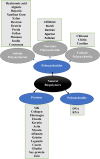Recent developments in natural biopolymer based drug delivery systems
- PMID: 37529365
- PMCID: PMC10388836
- DOI: 10.1039/d3ra03369d
Recent developments in natural biopolymer based drug delivery systems
Abstract
Targeted delivery of drug molecules to diseased sites is a great challenge in pharmaceutical and biomedical sciences. Fabrication of drug delivery systems (DDS) to target and/or diagnose sick cells is an effective means to achieve good therapeutic results along with a minimal toxicological impact on healthy cells. Biopolymers are becoming an important class of materials owing to their biodegradability, good compatibility, non-toxicity, non-immunogenicity, and long blood circulation time and high drug loading ratio for both macros as well as micro-sized drug molecules. This review summarizes the recent trends in biopolymer-based DDS, forecasting their broad future clinical applications. Cellulose chitosan, starch, silk fibroins, collagen, albumin, gelatin, alginate, agar, proteins and peptides have shown potential applications in DDS. A range of synthetic techniques have been reported to design the DDS and are discussed in the current study which is being successfully employed in ocular, dental, transdermal and intranasal delivery systems. Different formulations of DDS are also overviewed in this review article along with synthesis techniques employed for designing the DDS. The possibility of these biopolymer applications points to a new route for creating unique DDS with enhanced therapeutic qualities for scaling up creative formulations up to the clinical level.
This journal is © The Royal Society of Chemistry.
Conflict of interest statement
The authors declare no conflict of interest.
Figures
Similar articles
-
Micellar Drug Delivery Systems Based on Natural Biopolymers.Polymers (Basel). 2021 Feb 2;13(3):477. doi: 10.3390/polym13030477. Polymers (Basel). 2021. PMID: 33540922 Free PMC article. Review.
-
Recent advances in biopolymer-based advanced oxidation processes for dye removal applications: A review.Environ Res. 2022 Dec;215(Pt 1):114242. doi: 10.1016/j.envres.2022.114242. Epub 2022 Sep 5. Environ Res. 2022. PMID: 36067842 Review.
-
Recent Progress in the Synthesis and Biomedical Properties of Natural Biopolymer Composites.Curr Med Chem. 2021;28(40):8243-8266. doi: 10.2174/0929867328666201217104038. Curr Med Chem. 2021. PMID: 33334278 Review.
-
The Use of Chitosan, Alginate, and Pectin in the Biomedical and Food Sector-Biocompatibility, Bioadhesiveness, and Biodegradability.Polymers (Basel). 2019 Nov 8;11(11):1837. doi: 10.3390/polym11111837. Polymers (Basel). 2019. PMID: 31717269 Free PMC article. Review.
-
Recent Biomedical Approaches for Chitosan Based Materials as Drug Delivery Nanocarriers.Pharmaceutics. 2021 Apr 20;13(4):587. doi: 10.3390/pharmaceutics13040587. Pharmaceutics. 2021. PMID: 33924046 Free PMC article. Review.
Cited by
-
Synthesis of Quarternized Chitosans and Their Potential Applications in the Solubility Enhancement of Indomethacin by Solid Dispersion.AAPS PharmSciTech. 2024 Aug 6;25(6):179. doi: 10.1208/s12249-024-02893-9. AAPS PharmSciTech. 2024. PMID: 39107500
-
Biopolymeric Innovations in Ophthalmic Surgery: Enhancing Devices and Drug Delivery Systems.Polymers (Basel). 2024 Jun 16;16(12):1717. doi: 10.3390/polym16121717. Polymers (Basel). 2024. PMID: 38932068 Free PMC article. Review.
-
Sustainable Silk-Based Particulate Systems for the Controlled Release of Pharmaceuticals and Bioactive Agents in Wound Healing and Skin Regeneration.Int J Mol Sci. 2024 Mar 8;25(6):3133. doi: 10.3390/ijms25063133. Int J Mol Sci. 2024. PMID: 38542108 Free PMC article. Review.
-
Pharmaceutical Applications of Biomass Polymers: Review of Current Research and Perspectives.Polymers (Basel). 2024 Apr 23;16(9):1182. doi: 10.3390/polym16091182. Polymers (Basel). 2024. PMID: 38732651 Free PMC article. Review.
-
All-Natural Gelatin-Based Nanoemulsion Loaded with TLR 7/8 Agonist for Efficient Modulation of Macrophage Polarization for Immunotherapy.Nanomaterials (Basel). 2024 Sep 26;14(19):1556. doi: 10.3390/nano14191556. Nanomaterials (Basel). 2024. PMID: 39404283 Free PMC article.
References
-
- Talebian S. et al., Biopolymers for antitumor implantable DDS: recent advances and future outlook. Adv. Mater. 2018;30(31):1706665. - PubMed
-
- García M. C., DDS based on nonimmunogenic biopolymers, in Engineering of Biomaterials for DDS, Elsevier, 2018, pp. 317–344
Publication types
LinkOut - more resources
Full Text Sources


